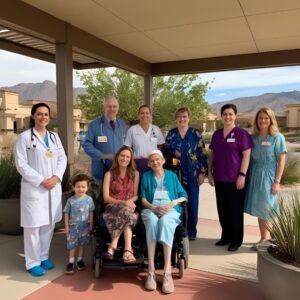Regular physical activity is essential for maintaining mobility, strength, and overall health in older adults. Tailored fitness classes can provide a safe and enjoyable way for seniors to stay active. Here are some popular fitness activities for older adults:
- Yoga and Tai Chi
- Yoga: Yoga classes for seniors focus on gentle stretches, balance, and breathing exercises. These classes can improve flexibility, reduce stress, and enhance mental clarity.
- Tai Chi: Tai Chi is a low-impact martial art that involves slow, deliberate movements. It is excellent for improving balance, coordination, and mental focus.
- Water Aerobics
- Water aerobics classes offer a low-impact workout that is easy on the joints. The buoyancy of water supports the body, making it an ideal exercise for those with arthritis or mobility issues.
- Walking Groups
- Organized walking groups provide a social and enjoyable way to stay active. Walking is a simple yet effective exercise that can be tailored to different fitness levels.
- Strength Training
- Strength training classes designed for older adults focus on building muscle mass and bone density. These classes typically use resistance bands, light weights, and body-weight exercises.
- Dance Classes
- Dance classes, such as ballroom dancing, line dancing, or Zumba Gold, offer a fun way to stay fit while learning new dance moves. Dancing improves cardiovascular health, coordination, and social interaction.
Educational Workshops for Lifelong Learning
Lifelong learning is essential for mental stimulation and personal growth. Educational workshops tailored to older adults can cover a wide range of topics and interests, promoting cognitive health and intellectual engagement. Here are some ideas for educational workshops:
- Technology Training
- Workshops that teach seniors how to use smartphones, tablets, and computers can help them stay connected with family and friends, access online services, and explore new hobbies.
- Art and Craft Classes
- Art classes, such as painting, pottery, and knitting, allow older adults to express their creativity and learn new skills. These classes can be therapeutic and provide a sense of accomplishment.
- Language Learning
- Learning a new language can be a stimulating and enjoyable activity. Language classes for seniors can focus on practical conversation skills and cultural exploration.
- Health and Wellness Seminars
- Educational seminars on health topics, such as nutrition, chronic disease management, and mental health, can empower older adults to make informed decisions about their well-being.
- History and Culture Lectures
- Lectures on history, culture, and current events can provide intellectual stimulation and foster discussions among participants. Guest speakers and experts can offer valuable insights.
- Gardening Workshops
- Gardening classes can teach seniors about plant care, landscape design, and sustainable practices. Gardening is a rewarding activity that promotes physical activity and connection with nature.
- Cooking Classes
- Cooking classes that focus on healthy, easy-to-make recipes can encourage older adults to maintain a nutritious diet. These classes can also explore culinary traditions from different cultures.
Social Gatherings for Community Building
Social interaction is vital for combating loneliness and fostering a sense of community among older adults. Organizing regular social gatherings can create opportunities for seniors to connect, share experiences, and build friendships. Here are some ideas for social gatherings:
- Coffee Mornings and Tea Parties
- Casual coffee mornings or tea parties provide a relaxed setting for seniors to chat and socialize. These events can be held at community centers, libraries, or cafes.
- Book Clubs
- Book clubs offer a chance for older adults to read and discuss books together. This activity promotes intellectual engagement and provides a platform for sharing perspectives.
- Game Nights
- Game nights featuring board games, card games, and trivia can be a fun and interactive way to bring people together. These events can stimulate cognitive function and encourage teamwork.
- Movie Screenings
- Regular movie screenings of classic films, documentaries, or new releases can be a delightful way for seniors to enjoy a shared experience. Follow-up discussions can enhance the experience.
- Music and Singing Groups
- Music groups, such as choirs or sing-alongs, provide a joyful way for seniors to express themselves and connect with others. Music has therapeutic benefits and can evoke positive emotions.
- Travel Clubs
- Travel clubs that organize day trips, excursions, or even virtual tours can satisfy the wanderlust of older adults. These outings provide opportunities for exploration and adventure.
- Cultural Festivals and Events
- Celebrating cultural festivals and holidays can bring a community together. Events can include traditional music, dance, food, and storytelling, fostering a sense of cultural pride and inclusivity.
- Intergenerational Programs
- Programs that bring together different generations, such as grandparent-grandchild activities, can promote mutual understanding and strengthen family bonds.
Implementing Programs and Activities
To successfully implement programs and activities tailored to older adults, it is essential to consider the following factors:
- Accessibility
- Ensure that venues are accessible to individuals with mobility issues. This includes providing ramps, elevators, and accessible restrooms.
- Affordability
- Offer programs at low or no cost to make them accessible to all seniors. Seek funding or sponsorships from local businesses, community organizations, and government grants.
- Flexibility
- Provide flexible scheduling options to accommodate different lifestyles and commitments. Offer both daytime and evening sessions to suit varying preferences.
- Promotion
- Use various channels to promote programs, including community bulletin boards, social media, local newspapers, and word of mouth. Encourage participants to bring friends and family members.
- Feedback
- Regularly seek feedback from participants to understand their needs and preferences. Use this feedback to improve and adapt programs to better serve the community.
Conclusion
Tailoring programs and activities to the interests and needs of older adults can have a profound impact on their well-being. Fitness classes, educational workshops, and social gatherings offer opportunities for physical activity, intellectual stimulation, and social interaction. By creating inclusive and engaging programs, we can enhance the quality of life for older adults, promote a sense of community, and ensure that they continue to lead fulfilling and meaningful lives.


